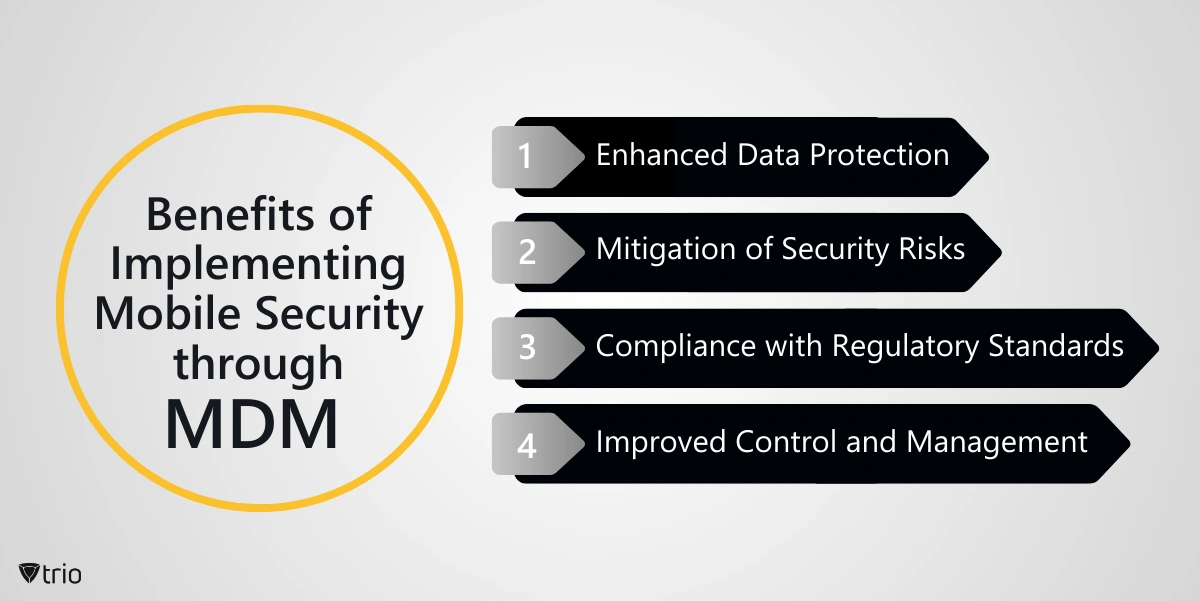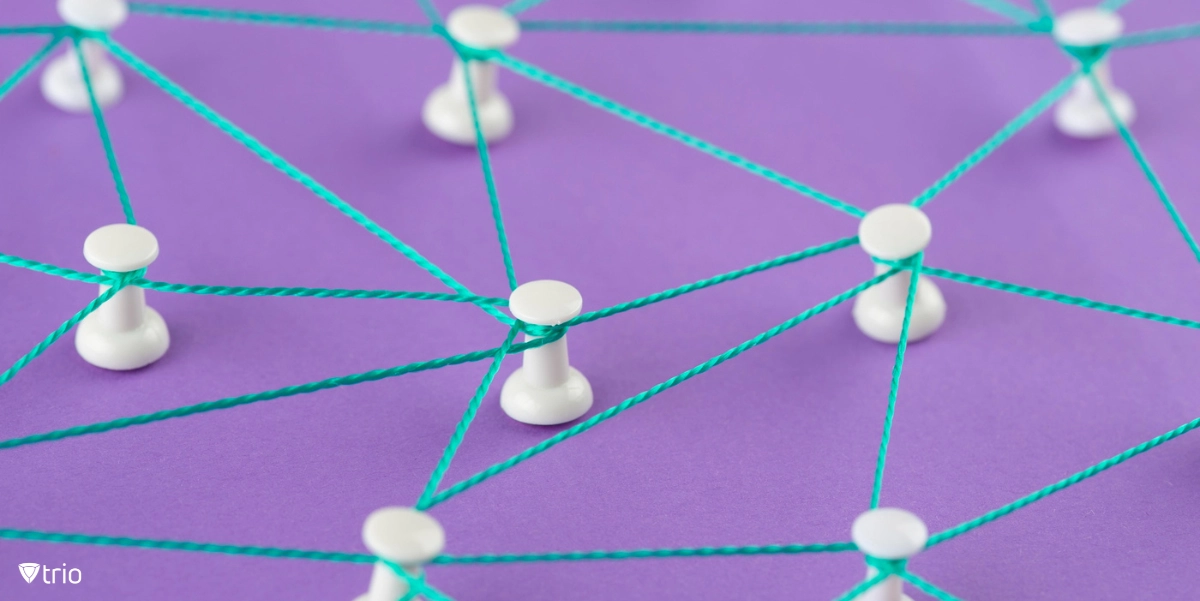The widespread use of mobile devices in the workplace presents significant security challenges. Sensitive company data is increasingly stored, accessed, and transmitted on smartphones and tablets, making them prime targets for cyberattacks. Robust mobile security measures are crucial to protect this data from unauthorized access, loss, or theft.
Mobile Device Management (MDM) plays a vital role in achieving this, offering centralized control and security features for effective data protection and a secure mobile environment. It’s a solution that enables IT administrators to remotely manage and secure mobile devices used within an organization. It provides a comprehensive framework for device enrollment, configuration, policy enforcement, application management, and data security.

Core Components of Mobile Security in MDM
Among all mobile security solutions, MDM plays a vital role in protecting organizations’ sensitive data and ensuring the overall security of their mobile environments. It provides a central platform to secure, manage, and enforce security policies on mobile devices, safeguarding data and mitigating security risks. Below is a complete list of the key components of MDM as an advanced mobile security solution:
Device Enrollment and Provisioning
Setting strong security configurations and policies during initial onboarding is crucial. An MDM allows Users to securely register their devices through a web portal or dedicated app, providing ownership verification and establishing a secure connection with the MDM server.
Additionally, the device downloads and applies the pre-defined MDM configuration profile containing security settings, restrictions, and access permissions. The MDM also verifies the device’s adherence to security policies and enforces any missing configurations.
Policy Enforcement
MDM acts as a digital guardian for organizations by enforcing consistent security policies on all managed devices. MDM can enforce strong passcodes, data encryption, and automatic updates – essentially building a three-layered defense against unauthorized access, company data breaches, and outdated software vulnerabilities.
This centralized control minimizes the risk of individual settings creating vulnerabilities and inconsistencies, significantly strengthening the organization’s overall mobile security posture. By enforcing the above-mentioned and other customizable policies, MDM builds a strong foundation for mobile security and effectively safeguards valuable corporate data.
Remote Device Management
MDM allows IT professionals to remotely track and locate enrolled devices. This helps identify lost or stolen devices, enabling their retrieval or recovery of sensitive information. Additionally, location tracking can enforce geofencing, restricting device access to sensitive data or functionalities when outside authorized zones.
In case of a security breach or lost/stolen device, MDM also empowers IT to remotely lock or wipe the device. Locking prevents unauthorized access to the device and its data while wiping securely erases all data, protecting sensitive information from falling into the wrong hands. These functionalities minimize the potential damage from compromised devices and ensure the security of mobile devices within an organization.
Application Management
Application management within MDM offers another layer of defense for organizational mobile security. First, MDM facilitates the creation of whitelists and blacklists for applications. Whitelisting permits downloading only pre-approved apps, significantly reducing the risk of malware or unauthorized software infiltrating the system. Conversely, blacklisting blocks access to specific malicious or undesirable apps, further enhancing security and preventing potential data breaches.
Second, MDM can automate app updates, ensuring employees are always using the latest and most secure versions of approved apps, patching potential vulnerabilities promptly. This comprehensive approach ensures only up-to-date, authorized, and secure applications are accessible on company devices.
Security Compliance and Reporting
MDM continuously monitors enrolled devices against pre-defined security policies, ensuring they adhere to essential security measures. These policies might include strong password requirements, multi-factor authentication, encryption protocols, and operating system updates. Non-compliant devices are flagged, allowing IT to promptly address potential security risks before they escalate.
MDM even takes mobile security a step forward, generating comprehensive reports detailing device security posture, compliance status, and potential vulnerabilities. These reports are crucial for security audits, providing evidence of adherence to regulatory requirements and highlighting areas for improvement. This transparency allows organizations to demonstrate their commitment to data protection and proactively address any identified security gaps.
Containerization and Segmentation
BYOD (Bring Your Own Device) allows employees to use their personal devices (phones, laptops, tablets) for work purposes. Many companies implement BYOD policies, offering convenience and flexibility for employees. However, it also introduces data security challenges. These challenges include the potential loss of sensitive information on personal devices and the increased difficulty of enforcing security measures on devices outside the organization’s direct control.
MDM can leverage containerization technology to create secure containers on devices. These containers act as isolated workspaces, keeping corporate data separate from personal data and applications. This segregation minimizes the risk of data breaches even if the device itself is compromised.
Integration with the Security Ecosystem
MDM can be integrated with the broader security ecosystem, enhancing organizational mobile security. For instance, MDM can integrate with Mobile Threat Defense (MTD) solutions, providing real-time threat detection and mitigation capabilities. MTD proactively scans devices for malicious activities, app vulnerabilities, and data breaches, complementing MDM’s focus on device management and policy enforcement. This combined approach offers a multi-layered defense against mobile security threats.
Additionally, MDM can be integrated with Identity and Access Management (IAM). IAM systems authenticate users and manage access permissions across various applications and resources. By integrating with MDM, IAM ensures that only authorized users can access corporate data on mobile devices, further reducing the risk of unauthorized access and data breaches. This combined approach provides a centralized and secure way to manage user access across all devices and applications.

Benefits of Implementing Mobile Security through MDM
As we discussed earlier, MDM plays a vital role in businesses’ mobile security. Below is a recap of the advantages of opting for an MDM to enhance mobile security:
Enhanced Data Protection
MDM safeguards sensitive corporate data by enforcing security policies, controlling app access, and offering data encryption and containerization.
Mitigation of Security Risks
MDM helps IT risk management by controlling device access, detecting and preventing malware threats, and enabling remote wipe and lock capabilities.
Compliance with Regulatory Standards
MDM facilitates compliance with data privacy regulations like GDPR and CCPA by providing tools for data segregation, access controls, and reporting.
Improved Control and Management Capabilities
MDM empowers IT administrators with centralized control over device enrollment, configuration, app management, and security policy enforcement, streamlining device management and enhancing security posture.
Challenges and Considerations
Utilizing MDM as a tool for establishing mobile security comes with its own set of challenges. Here are some of the most important:
Negative User Experience
While robust security measures are crucial, it’s essential to be mindful of user experience. Overly restrictive policies can hinder productivity and user satisfaction. Make sure that the MDM solution you choose is customizable enough to achieve a balance between security and user satisfaction.
Employees’ Privacy Concerns
Implementing MDM solutions raises privacy concerns regarding employee device monitoring and data access. Organizations need to establish clear policies and transparent communication with employees to address these concerns and ensure responsible data management.
Evolving Threat Landscapes
The mobile security landscape is constantly evolving, with new threats emerging regularly. It’s crucial to stay updated on the latest threats and adapt security policies and configurations accordingly.
Lack of Accessibility and Usability
MDM solutions should be user-friendly and accessible to all employees, regardless of their technical expertise. User training and clear communication are essential for ensuring effective adoption and minimizing disruption.
Final Word
Mobile security is paramount in today’s mobile-centric world. MDM plays a critical role in safeguarding corporate data and organizational privacy by providing a comprehensive framework for mobile device management and security. That’s why we developed Trio, a comprehensive Mobile Device Management (MDM) platform designed to empower businesses to confidently manage and secure their mobile environment.
Trio equips you with the tools to safeguard your organization’s data from threats like Spyware through features like granular policy control, real-time device insights, and automated security actions. Whether you need to enforce strong passcodes, manage app installations, or remotely wipe compromised devices, Trio offers a streamlined and user-friendly experience for comprehensive mobile security management.
By incorporating measures to combat Spyware alongside granular policy control and real-time device insights, Trio ensures that your organization’s data remains protected against evolving threats in the mobile landscape.
Ready to experience the future of mobile security? Sign up for your free demo today and discover how our platform can help you protect your organization’s valuable data.








